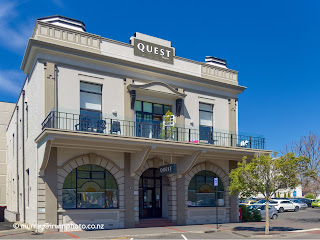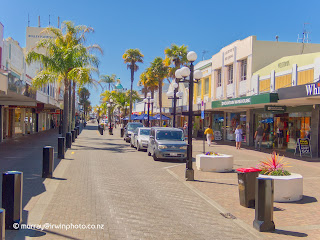10/10/2023
Our next destination was Castle Point, also on the East Coast of Wairarapa. Another popular holiday destination with a sandy beach, however, dominated from every angle by the 23 metre high cast iron Castle Point lighthouse, standing 52 metres above the ocean on a rocky promontory. The Castle Point lighthouse first shone 35 kilometres out to sea in 1913, intended to assist inbound international shipping from Panama to Wellington with safe landfall.
Beside visiting the lighthouse there are plenty of other activities one can do including swimming, surfing, fishing and walking on the beach or surrounding hills. If you have a head for heights you could climb to the top of Castle Rock, 162 metres above sea level.


11/10/2023
As we were about to leave the provence behind we had to admit that our impressions of Wairarapa had changed considerably for the better. We noted the obvious civic pride of the residents with well maintained properties and facilities, particularly the many beautifully restored historic buildings in all the major towns. Wairarapa for us had a great feel and we could live there happily.
There is still the odd building awaiting a renovation back to it's former glory.
Back to the adventure. Our plan was to head to Te Paerahi ( Porangahau Beach) because it looked interesting. After refuelling at Masterton, the 160 kilometre trip along Route 52 had a duration of 2 hours and 37 minutes according to Google Maps. Our travelling time was closer to four and a half hours over narrow, winding and ever worsening roads, showing the cyclone damage inflicted earlier this year. State Highway 52 felt like we were driving in a long past era. On the stretch from Te Ore Ore to Pongaroa, a distance of 86 kilometres, we passed 13 vehicles travelling in the opposite direction and many fewer heading our way. After a much needed break and late lunch upon reaching Pongaroa, we continued, stopping at our parking place for the night late that afternoon.
For the Tennis enthusiasts among you, we passed by the Wimbledon Tavern in Wimbledon.
Shortly after that we came upon the place with the longest name in the world, according to The Guiness Book of World Records, at 85 letters.
Te Paerahi ( Porangahau Beach), proved to be yet another lovely sandy beach 14 kilometres long, however less developed and populated. A quiet relaxing evening and night after a hectic day.

12/10/2023
Leaving Te Paerahi, we made our way through Waipukurau and Havelock North to ascend the sealed road to the summit car park of Te Mata Peak. This peak rises steeply to a maximum height of 399 metres, offering commanding views of Hawkes Bay, Napier, Hastings, Havelock North, the Tukituki Valley and in suitable conditions, Mount Ruapehu and the Mahia Peninsula. On it's western side steep grassland decends to Havelock North criss crossed by walking tracks and MTB trails, while on the eastern side huge cliffs drop into the Tukituki Valley. Te Mata Peak was gifted to the Public in 1927 as a park in perpetuity by the descendants of John Chambers who farmed Te Mata Peak from the 1850's. A great public asset.
Following our visit to Te Mata Peak we made our way to Clifton Road Reserve where we spent the afternoon enjoying the great weather at this beachside free camping area.
13/10/2023
A clear morning made for a colourful pre-dawn sky looking along the beach toward Cape Kidnappers.
Today we decided we needed a couple of quieter days to catch up on grocery shopping and chores, with a bit of sightseeing around Napier. After we had travelled into Napier we found a quiet public car park at Perfume Point on the foreshore to consult Google Maps. There we noticed five brightly coloured outdoor chairs, presumably sculptural, which appear quite normal at a small distance until you have a point of reference or scale. With Sara sitting on one it was obvious that these chairs were carefully proportioned copies, two to three times life size. Interesting the ways our eyes can be tricked.
Having consulted Google Maps we proceeded to the Napier Port lookout on Bluff Hill. From here it is obvious that this is a major logging port supporting the extensive forests of Pinus Radiata grown in the Napier and Gisborne regions. Major it is, with two and a half million tons of export logs crossing the wharves at Napier annually, making this the most significant timber port in New Zealand.
In the afternoon we walked on the Ahuriri Estuary loop track.
Prior to the 1931 Napier earthquake the Ahuriri Lagoon covered around 4000 hectares, virtually surrounding Napier City. During the earthquake the land under the lagoon was uplifted 1.5 to 2 metres exposing parts of the seabed and reducing the area of the lagoon by about 3000 hectares. The Napier Airport is built on what was lagoon seabed, along with some of the Western suburbs. Ahuriri Estuary is now a sanctuary for wading birds.
14/10/2023
Strangely, despite the tragedy and destruction caused by the 1931 Napier Earthquake, it has become a defining factor in the cities identity. As mentioned before, the creation of land for the expanding suburbs of this growing city. Also the architectural style and character of the rebuilt city of Napier. At the time Napier was rebuilding, the Art Deco style of architecture was fashionable and popular. Consequently, large numbers of buildings and houses built in Napier at this time were created in this flambouyant style. We took a little time to walk through the city centre to photograph a few examples that caught our eyes.
Addition.
On a subsequent visit to Napier area in December 2024 we visited the historic site of Maraetotara Falls. After a short drive from Havelock North you will find this popular swimming hole at the base of the falls and a historic river walk with relics from the Havelock North hydro electric dam and power station. With the addition of the 1.8 metre high concrete Mokopeka Dam which was constructed on top of the Maraetotara Falls in the early 1920's to raise the water head for the power station, this is a very picturesque cascade.
15/10/2023
Today we continued our journey north to Lake Tutira where we parked for the night. Unfortunately the DOC campsite here was closed temporarily due to cyclone damage, which was disappointing as it is beautiful and tranquil.


16/10/2023 - 19/10/2023
Moving on to Wairoa, I stopped our motorhome in the middle of the Mohaka River bridge while Sara quickly photographed the impressive Mohaka River railway viaduct. This steel structure is part of the disused Napier to Gisborne railway line and with a length of 277 metres and a maximum height of 95 metres it is the tallest viaduct in Australasia.
After making a brief stop for last minute groceries in Wairoa we turned inland destined for Lake Waikaremoana, which held a bit of intrigue for me. So visiting Lake Waikaremoana was on my list of Must Do's on our North Island journey. Located about 60 kilometres northwest of Wairoa at an altitude of 580 metres above sea level and maximum depth of 220 metres, Lake Waikaremoana covers an area of 54 square kilometres within Te Urewera. Our first night was spent at Mokau Landing DOC campsite in Mokau Inlet completely on our own.
With no other campers, no cellphone service and no internet we enjoyed a very quiet and peaceful night. I say no cellphone or internet service as we have both on our motorhome through the Spark national cellphone network and the Rural Broadband network through provider Wireless Nation. Both systems deliver very different service coverage, often giving us no service on one but a strong signal on the other. In short, we are very seldom with no communication at all.
The following day we transferred back to Waikaremoana Holiday Park at Te Karetu Inlet, stopping on the way to look at the picturesque Mokau Falls.
After a hot shower and a good night sleep, we were ready to tackle the two and a half hour return, 310 metre climb up to Lake Waikareiti, after first visiting the Aniwaniwa Falls.
On arrival at our destination of Lake Waikareiti we were greeted by a fresh cool wind in our faces which hastened our departure and return to our vehicle.
Back on the dusty, winding, gravel road again, we made our way to our campsite for our last night, at Rosie Bay, where once again we were alone for the night. Rosie Bay is notable for the huge block like rock formations on the hills above.
Departing the next day after three lovely peaceful and relaxing days surrounded by beautiful native forest and bush, I have now satisfied my curiosity regarding Lake Waikaremoana.
While we were in the remote surroundings of Lake Waikaremoana our water pump stopped working. This made life a little awkward with no running water onboard our motorhome. However, after purchasing some dressmakers pins and a roadside fixit job in Wairoa we were on our way again to Oraka Beach on the Mahia Peninsula for the night, with running water again and time to get in an evening walk on the beach.

20/10/2023
An early start was required today as we had made a booking for an adventure on the Napier to Gisborne railway. Our pre-dawn roll out of bed was rewarded with a very colourful sky over Oraka Beach.
But no matter how much we liked Oraka and Mahia beaches, we had to depart for our rendezvous much closer to Gisborne. You can join us on our Railbike Adventure at our separate
Railbike post.




















































































































































